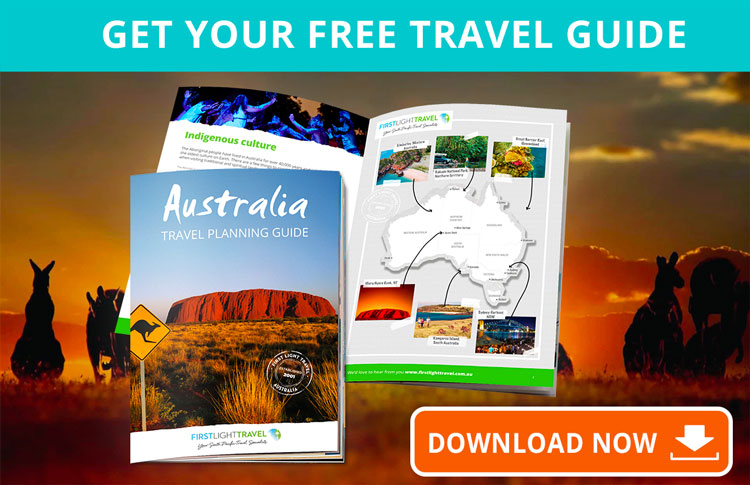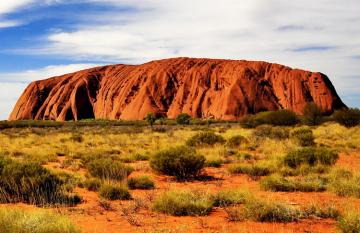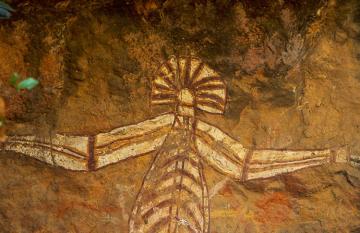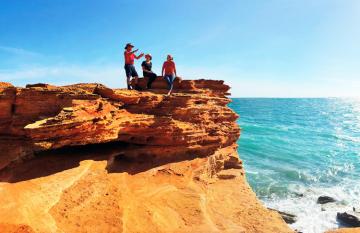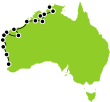
Why might you NOT want to visit Uluru in July? When should you avoid snorkelling the Great Barrier Reef? Our season-by-season guide will help you pick the perfect time to visit your must-see Aussie destinations.
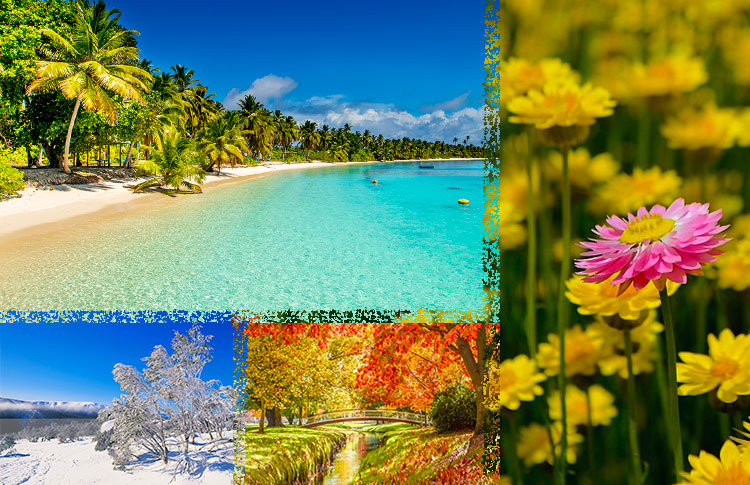
If Australia is high on your bucket list (and it should be), you might be wondering when is the best time of year to visit.
Seasons in Australia are the opposite way round to U.S. and European seasons, so it's a bit confusing!
Fear not: our season-by-season guide will help you decide. You'll be booking flights before you know it.
Ready to dive in? Let's start with the basics:
When are Spring, Summer, Autumn and Winter in Australia?
Australian Seasons Explained
- Summer in Australia is December, January and February
- Autumn/Fall in Australia is March, April and May
- Winter in Australia is June, July and August
- Spring in Australia is September, October and November
In other words: whatever the weather's doing in the Northern Hemisphere, in Australia it's usually doing the opposite! This is great news if you're looking to escape a grey, rainy British winter, for example.
Use our Australian Weather Widget to find average temperatures in your favourite Aussie destinations
Two Extra Seasons: The Wet and the Dry
But Australia doesn't stop at just four seasons. There are a couple more to contend with...
In the Tropical Northern parts of Australia, there is a Wet Season and a Dry Season.
You'll find this in the northern parts of Western Australia, the Northern Territory and Queensland.
- Wet Season: Roughly November to April
- Dry Season: Roughly May to October
The Wet Season's weather is hotter and wetter, while the Dry Season is cooler and dryer.
Cyclone Season
In Northern Australia there is also a Cyclone Season from November to April.
Don't panic: while there are 13 cyclones in Australia per year on average, only half of these become severe. In fact, many of them don't make landfall.
Still, it's important to be aware of Cyclone Season when you're planning a holiday in the northern parts of Australia.
Popular destinations affected by Cyclone Season include:
- Western Australia - Northwestern Coast, Exmouth and Coral Bay
- The Top End - Kakadu, the Kimberley, Broome, Darwin
- Queensland - Great Barrier Reef, Cairns, Whitsunday Islands, Daintree Rainforest
You needn't avoid these areas altogether - but if you want to visit them between November and April, keep an eye on the weather and ensure you can be flexible with your itinerary if necessary.
So what can you expect during each Australian season? Where are you likely to find the best weather? Here's a breakdown:
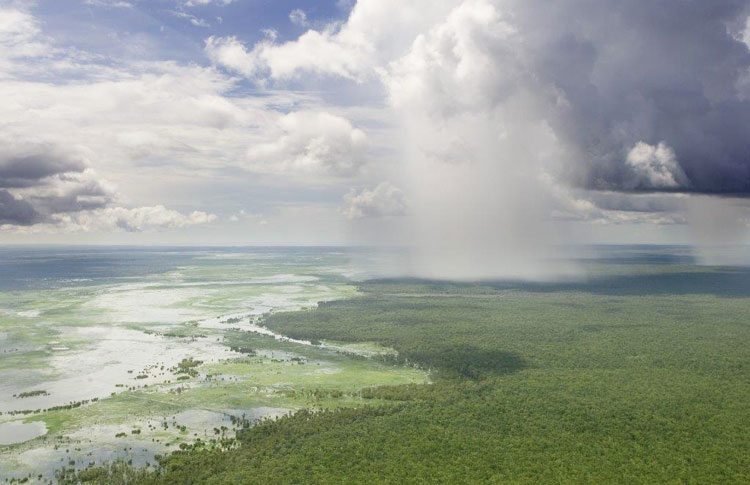
Summer in Australia: December, January, February
Ideal for: beach holidays, coastal drives, visiting the south
Weather-wise, most of Australia is warm and sunny in the summer months.
Summer in Australia is a time to celebrate: Christmas, New Year, and the Australia Day public holiday all occur in summer, so you are spoiled for fireworks and festivals!
Great Australian Summer Destinations
The country's coolest regions (Tasmania, Victoria and South Australia) are at their warm, sunny best in December, January & February.
Try these itinerary suggestions:
A Great Ocean Road itinerary that's perfect for a summer road trip
Explore Sydney, the Blue Mountains & Hunter Valley in seven summery days
Things To Be Aware Of When Travelling In In Summer
- Cyclone Season in the Far North
- The Red Centre, Top End & Outback Australia experience soaring temperatures in summer
- Accommodation prices skyrocket around Christmas and New Year - it coincides with the long school summer holiday, so demand is high.
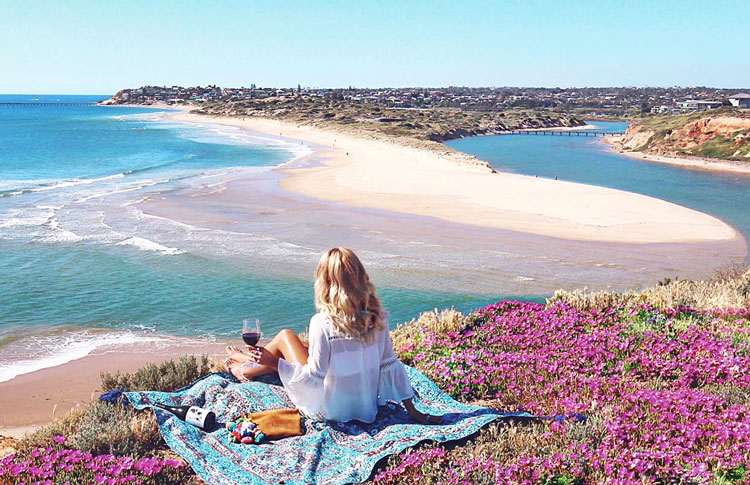
Autumn (Fall) In Australia: March, April, May
Ideal for: hiking and outdoor Aussie adventures.
Autumn is a great time to travel: the summer crowds have gone home, school holidays are over and the weather is still sunny if a little cooler. In many parts of Australia there's an increase in rainfall, but it's a pleasant season to travel with less extreme temperatures.
The mild temperatures mean it's the perfect time for hiking. By May, the Tropical North's Wet Season is coming to an end, so the flood risk dies down and the Top End's incredible attractions reopen to visitors.
Great Autumn Destinations
Watch the autumn leaves turn from green to golden in Tasmania. Or drive through Australia's famous wine regions and take advantage of the wine festivals. Alternatively, It's whale and shark season in Western Australia - tour the Coral Coast to catch a glimpse of these beauties.
Looking for itinerary ideas? Try these:
Spend 8 days touring Tasmania's natural wonders
A week-long self-drive itinerary featuring Margaret River's beautiful vineyards and coastline
Follow Indian Ocean Drive to Western Australia's breathtaking Coral Coast in 11 days
Things To Be Aware Of When Travelling In Autumn
- If travelling around the Easter holidays, book early to avoid disappointment.
- Leave the Tropical North until late autumn to avoid the Wet Season's humidity.
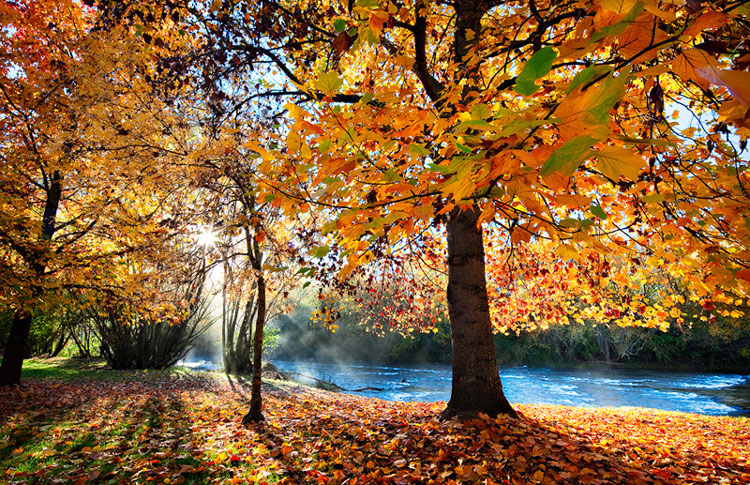
Winter Holidays in Australia: June, July, August
Ideal for: outback adventures, tropical sun and even winter snow!
In much of Australia, winter means cooler (but often still sunny) days and colder nights.
With temperatures staying above freezing pretty much everywhere, Aussie winters are mild and it can be a great time of year to travel. If winter warmth seems like a strange concept, you can get your snow fix in the mountains of Victoria & New South Wales instead.
Great Winter Destinations
Hit the snow in the Australian Alps: the country's highest mountain range stretches from New South Wales to Canberra and Victoria. Or tackle the Top End and Northern Territory: the weather will be cooler and dryer so you can enjoy Uluru, Kakadu, Litchfield National Park and Darwin to your heart's content.
Winter is also the best time to visit the Great Barrier Reef: low rainfall means clearer waters and better views, the temperature is mild, and there are no stingers (box jellyfish) to avoid!
Here are some winter ideas from our itinerary library:
Ride camels through the desert on a 5 day Red Centre Family Adventure
Get off the beaten track in style with a luxury fly/drive Darwin to Adelaide journey
Things To Be Aware Of When Travelling In Winter
- If you're looking for a beach holiday, southern Australia is best avoided in winter.
- Outback & desert areas will be warm during the day, but cold at night.
- Many cool-weather states host incredible culture & food festivals - VIVID in Sydney and Dark Mofo in Hobart are well worth braving the chill!
Spring: September, October, November
Ideal for: spring flowers, sunshine and stylish cities
With temperatures still mild but on the rise, and flowers in bloom, spring is a lovely time of year to visit Australia. If you aren't a fan of extreme heat, it could be the best time for you.
With flower festivals taking place across the nation and spring racing carnival fever, there's much to explore and enjoy. It's perfect for outdoor activities like hiking and mountain biking too.
Great Spring Destinations
Western Australia has the largest collection of wildflowers on the planet. Take a tour to Perth, Margaret River or a road trip along the Indian Ocean Drive for a jaw-dropping display of nature at its finest.
Don your finest frock or tuxedo and head to Melbourne's Spring Racing Carnival in November - the state even has a public holiday for the iconic Melbourne Cup horse race and you'll see the townsfolk dressed up to the nines.
Not to be outdone, Sydney also hosts a grand Spring Racing Carnival, as well as Sculpture By the Sea. This outdoor art installation along the cliffs between Bondi and Coogee draws millions of visitors in late October/early November.
The Top End is still in Dry Season in September and October, so you can fit in an early spring visit. It's one of the best times for birdwatching in Kakadu National Park.
Fresh spring itinerary ideas:
Quench your thirst for adventure on an exhilarating 5 Day Top End road trip
Tips For Travelling In Spring
- Planning to visit the Tropical North? Remember: September and October are in the Dry Season. November is in the Wet Season.
- If you're coming in Spring, be sure to visit the Top End, Coral Coast, or Tropical North Queensland during the early days of your trip.
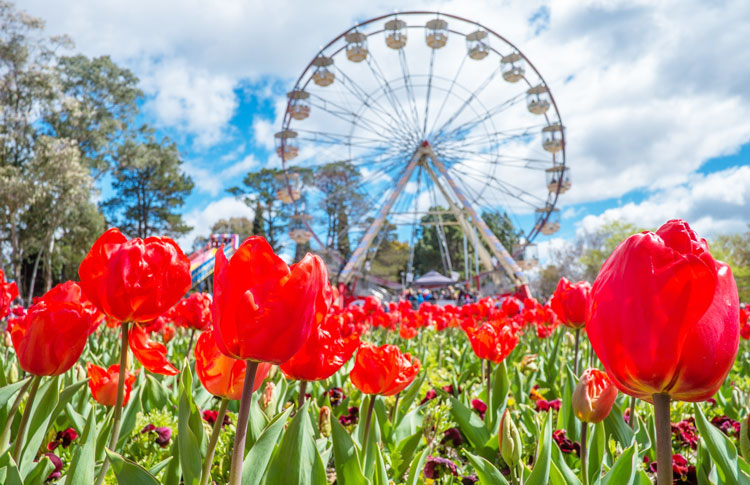
Visiting multiple states: the best season to travel
You're flying a long way to visit Australia, so you might as well visit more than one part of the country. How does the time of year affect your travel plans?
If you're planning an Australia road trip through several states, how do you maximise your chances of good weather when the climates are so different? Especially if you want to visit the hotter and more tropical regions?
Don't let the off-season put you off!
Travelling off-season is your best bet: plan your itinerary around the Wet Season and Dry Season changeover in Spring or Autumn. You'll miss the temperature extremes and still have nice weather.
Sounds confusing? Here are some examples:
Example 1: Aussie Icons in October
Let's say you've always wanted to see the Sydney Opera House, Uluru (Ayers Rock) and the Great Barrier Reef. October's a great time to cross them off your bucket list - here's why:
- You begin in Sydney's springtime with gorgeous flowers and balmy temperatures - warm enough for a Bondi swim.
- You'll explore Uluru before the extreme desert summer kicks in.
- The Great Barrier Reef is still in Dry Season, meaning less risk of stingers (jellyfish) while you snorkel among the coral, and less humidity than the upcoming Wet Season.
10 Day Sydney, Rock and Reef Itinerary
Example 2: South to North in Autumn/Fall
Another off-season example: if you want to travel the length of Australia from Adelaide to Darwin, late April would be a great time to start because:
- Begin in Adelaide in late April - it's mid-autumn, so the days are usually still warm enough to enjoy the outdoors even though the nights are getting cooler.
- You'll cross the outback and the Red Centre in May, avoiding the extreme summer heat so you can make the most of the other-worldly desert landscapes.
- You'll arrive in Australia's Top End in May - perfect timing to avoid the tropical Wet Season, when star attractions such as Litchfield National Park and Katherine Gorge are partially or fully closed due to flood risk.
A 12 day Adelaide to Darwin self-drive itinerary following the legendary Explorer's Way
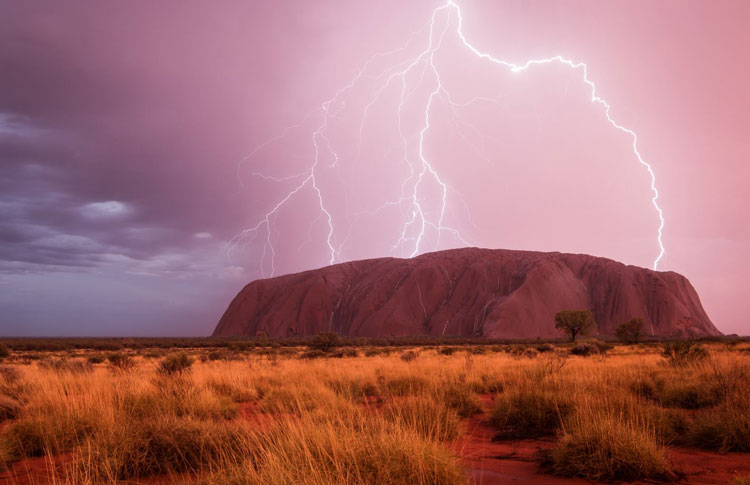
Best Time to Travel: outdoor activities by season
Planning to hike the Overland Trail? Hoping to spot a humpback whale? If outdoor activities are high on your bucket list, here's the best time to plan your adventures:
For Hikers
Spring and Autumn (Fall) have the best balance of temperatures and uncrowded trails. You can of course hike in summer and winter too, but avoid mountain areas in winter unless you're experienced and well prepared, and try some coastal walks instead. And don't forget to carry at least 2-3 litres of water for day hikes in the summer heat.
For Snow Lovers
Peak snow season is July to early September. There may be snow from June right through to early October - that's right, you can ski during spring! During mid-winter (July/August) there will be a bigger selection of runs available, but the July school holidays mean larger crowds and higher prices.
For Whale Watchers
Winter means whales! Between June and September there are prime whale-spotting opportunities in Queensland, Western Australia, Victoria, New South Wales and Tasmania. In some of these states you can see whales right the way through from May to November.
For Outback Exploration
The most comfortable time to visit the outback is during the Australian winter / dry season (May to October). Daytime temperatures will be warm and pleasant at this time, but remember that the mercury drops considerably at night - bring your warm pyjamas.
For Beach Bums
Do you want to have the beaches to yourselves? If so, avoid travelling between Christmas and February, when Australian schools have their long summer holiday. In the southern states, November to early December and March to early April are likely to have the best balance of empty beaches and warm sunshine. For a beach holiday during the Australian winter, the Tropical North will provide your daily dose of vitamin D.
Has this article helped you decide the best time of year to take your Great Australian Vacation?
We hope you now have a much better understanding of how each season can affect your travel plans. Here are the most important things to remember about Australia's seasons when planning your trip:
- Australia's seasons are at the opposite time to UK/European seasons.
- Far North Australia has a Wet Season and Dry Season, so make sure you plan around these.
- Shoulder seasons (spring and autumn/fall) are great times to plan a multi-state trip and avoid extremes of temperature.
- Whichever time of year you travel, you'll have a great time!
Further Reading: Our In-Depth Seasonal Guides
Don't forget to check out our guides to each Australian season - they cover seasonal festivals, attractions, weather and busy periods in much more depth to help to fine-tune the details of your trip.
Visiting Australia in Spring
Visiting Australia in Summer
Visiting Australia in Autumn/Fall
Visiting Australia in Winter
And if all these seasons have you stumped, why not ask the experts to give you a hand with your holiday planning? First Light Travel's Itinerary Planning Service is completely free, so take advantage of our local knowledge today!
Recent Posts
Blog Categories
Blog archives
- April 2024 (1)
- March 2024 (13)
- February 2024 (3)
- January 2024 (5)
- December 2023 (6)
- November 2023 (4)
- October 2023 (11)
- September 2023 (2)
- August 2023 (6)
- July 2023 (2)
- June 2023 (17)
- May 2023 (3)
- April 2023 (5)
- March 2023 (8)
- February 2023 (9)
- January 2023 (12)
- December 2022 (9)
- November 2022 (12)
- October 2022 (12)
- September 2022 (12)
- August 2022 (6)
- July 2022 (9)
- June 2022 (7)
- May 2022 (3)
- April 2022 (4)
- March 2022 (6)
- February 2022 (1)
- January 2022 (4)
- December 2021 (2)
- November 2021 (3)
- October 2021 (1)
- September 2021 (4)
- August 2021 (10)
- July 2021 (13)
- June 2021 (6)
- April 2021 (2)
- March 2021 (2)
- February 2021 (1)
- January 2021 (1)
- December 2020 (2)
- November 2020 (3)
- October 2020 (2)
- September 2020 (1)
- August 2020 (1)
- July 2020 (1)
- June 2020 (1)
- May 2020 (1)
- April 2020 (1)
- March 2020 (1)
- February 2020 (2)
- January 2020 (4)
- December 2019 (2)
- November 2019 (1)
- October 2019 (1)
- September 2019 (5)
- August 2019 (1)
- July 2019 (5)
- June 2019 (1)
- May 2019 (1)
- April 2019 (1)
- March 2019 (1)
- February 2019 (1)
- January 2019 (1)
- December 2018 (1)
- October 2018 (1)
- May 2018 (1)
- February 2018 (1)
- December 2017 (1)
- October 2017 (1)
- June 2017 (1)
- May 2017 (1)
- February 2017 (1)
- January 2017 (1)
- September 2016 (1)
- August 2016 (2)
- July 2016 (1)
- June 2016 (1)
- May 2016 (1)
- April 2016 (1)
- December 2015 (1)


